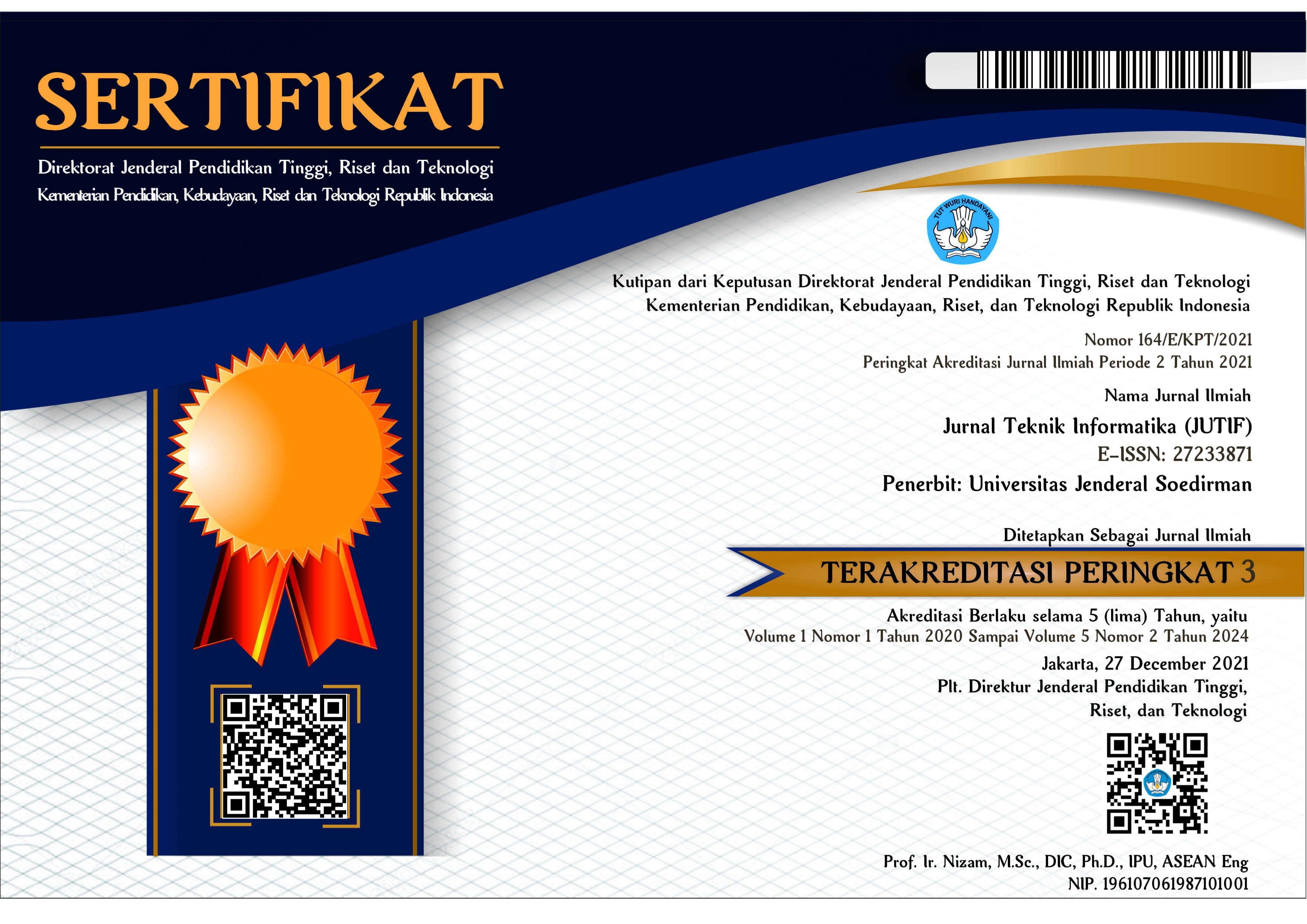IMPLEMENTATION OF THE RANDOM FOREST ALGORITHM IN CLASSIFYING THE ACCURACY OF GRADUATION TIME FOR COMPUTER ENGINEERING STUDENTS AT DIAN NUSWANTORO UNIVERSITY
DOI:
https://doi.org/10.52436/1.jutif.2023.4.3.920Keywords:
Classification, Graduation, Random Forest, StudentAbstract
To ensure the existence of a university remains intact, one way that can be done is by optimizing the performance of the students so that they can graduate on time. A high percentage of on-time graduation will result in a good assessment of the accreditation of the department in the university. However, there are many factors that affect the graduation rate, such as the student's academic performance, extracurricular activities, and other factors. The data of graduation of students in the Computer Science program at the Faculty of Computer Science, Dian Nuswantoro University, for the academic years 2008-2017 is the object of this study. The objective of this research is to create the best classification model using the Random Forest algorithm to predict the accuracy of the graduation time of students, which will be useful for policy making in the future. The results of the classification using this algorithm received an accuracy of 93% for the training data and 91% for the test data.
Downloads
References
E. Purnamasari, D. P. Rini, and Sukemi, “The Combination of Naive Bayes and Particle Swarm Optimization Methods of Student’s Graduation Prediction,” Jurnal Ilmiah Teknik Elektro Komputer dan Informatika, vol. 5, no. 2, pp. 112–119, Feb. 2019, doi: 10.26555/jiteki.v5i2.15317.
E. Ismanto and M. Novalia, “Komparasi Kinerja Algoritma C4.5, Random Forest, dan Gradient Boosting untuk Klasifikasi Komoditas,” 2021.
E. S. Susanto and H. Al Fatta, “Prediksi Kelulusan Mahasiswa Magister Teknik Informatika Universitas Amikom Yogyakarta Menggunakan Metode K-Nearest Neighbor,” 2018.
L. O. M. Zulfiqar, N. Renaningtias, and M. Y. Fathoni, “Educational Data Mining in Graduation Rate and Grade Predictions Utilizing Hybrid Decision Tree and Naïve Bayes Classifier,” Jul. 2020, pp. 151–157. doi: 10.5220/0009907101510157.
B. A. Arifiyani and R. S. Samosir, “Sistem Simulasi Prediksi Profil Kelulusan Mahasiswa Dengan Decison Tree,” Kalbiscentia, vol. 5, no. 2, 2018.
I. D. Mienye, Y. Sun, and Z. Wang, “An improved ensemble learning approach for the prediction of heart disease risk,” Inform Med Unlocked, vol. 20, Jan. 2020, doi: 10.1016/j.imu.2020.100402.
A. Yanuar, “Random Forest,” Universitas Gadjah Mada Menara Ilmu Machine Learning, Jul. 28, 2018. https://machinelearning.mipa.ugm.ac.id/2018/07/28/random-forest/ (accessed Oct. 23, 2022).
R. Aprillya, Perbandingan, M. Klasifikasi, R. A. Putri, and N. S. Fatonah, “Perbandingan Metode Klasifikasi serta Analisis Faktor Akademis Pola Kelulusan Mahasiswa di Perguruan Tinggi,” vol. 7, no. 2, 2022.
P. Probst, M. N. Wright, and A. L. Boulesteix, “Hyperparameters and tuning strategies for random forest,” Wiley Interdisciplinary Reviews: Data Mining and Knowledge Discovery, vol. 9, no. 3. Wiley-Blackwell, May 01, 2019. doi: 10.1002/widm.1301.
J. Zeniarja, A. Salam, and F. A. Ma’ruf, “Seleksi Fitur dan Perbandingan Algoritma Klasifikasi untuk Prediksi Kelulusan Mahasiswa,” Jurnal Rekayasa Elektrika, vol. 18, no. 2, Jul. 2022, doi: 10.17529/jre.v18i2.24047.
C. Cahyaningtyas, D. Manongga, and I. Sembiring, “Algorithm Comparison And Feature Selection for Classification of Broiler Chicken Harvest,” Jurnal Teknik Informatika (Jutif), vol. 3, no. 6, pp. 1717–1727, Dec. 2022, doi: 10.20884/1.jutif.2022.3.6.493.
U. Erdiansyah, A. Irmansyah Lubis, and K. Erwansyah, “Komparasi Metode K-Nearest Neighbor dan Random Forest Dalam Prediksi Akurasi Klasifikasi Pengobatan Penyakit Kutil,” Jurnal Media Informatika Budidarma, vol. 6, no. 1, p. 208, Jan. 2022, doi: 10.30865/mib.v6i1.3373.
W. Hastomo, N. Aini, A. Satyo, B. Karno, and L. M. R. Rere, “Metode Pembelajaran Mesin untuk Memprediksi Emisi Manure Management,” 2022.
R. Wajhillah, S. Bahri, and A. Wibowo, “Komparasi Metode Machine Learning pada Diagnosa Gangguan Kejiwaan Depresi,” 2020. [Online]. Available: https://www.kaggle.com/everseek/depression
S. Linawati, Siti Nurdiani, Kartika Handayani, and Latifah, “Prediksi Prestasi Akademik Mahasiswa Menggunakan Algoritma Random Forest Dan C4.5,” Jurnal Khatulistiwa Informatika, vol. VIII, no. 1, 2020, [Online]. Available: www.bsi.ac.id
R. Rachmatika and Achmad Bisri, “Perbandingan Model Klasifikasi untuk Evaluasi Kinerja Akademik Mahasiswa,” JEPIN (Jurnal Edukasi dan Penelitian Informatika) , vol. 6, no. 3, 2020.
M. H. Setiono, “Komparasi Algoritma Decision Tree, Random Forest, Svm Dan K-Nn Dalam Klasifikasi Kepuasan Penumpang Maskapai Penerbangan,” INTI Nusa Mandiri, vol. 17, no. 1, pp. 32–39, Oct. 2022, doi: 10.33480/inti.v17i1.3420.











